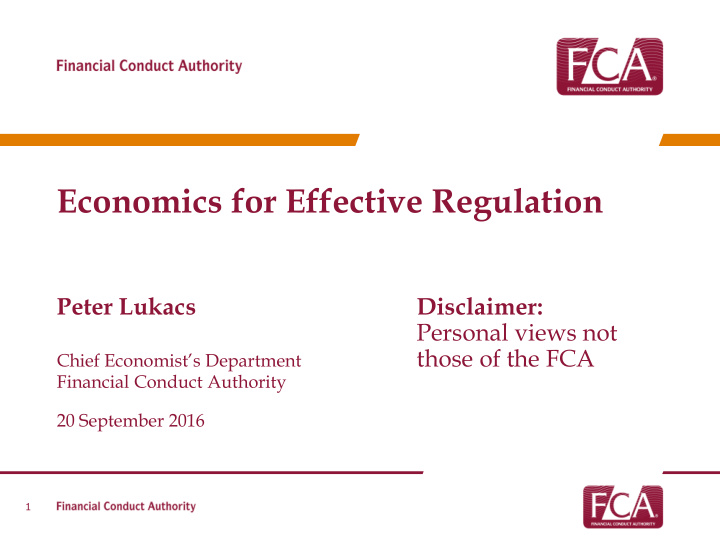



Economics for Effective Regulation Peter Lukacs Disclaimer: Personal views not those of the FCA Chief Economist’s Department Financial Conduct Authority 20 September 2016 1
Summary These slides were presented by Pete Lukacs of the Financial Conduct Authority (FCA) at the launch workshop of the UKCN c onsumer r emedies project held at the Competition and Markets Authority on 20 September 2016. The theme of this workshop was ‘linkages between consumer behaviour and remedies’. This presentation reviews the FCA’s ‘Economics for Effective Regulation’ occasional paper, which was published on 3 March 2016. The presentation begins by setting out the broad aims of this paper before describing some of the reasons that prompted its publication and the underlying principles that shaped its design. Next, the presentation provides an overview of the main methodological stages introduced in the paper. It finishes with a detailed walkthrough of the three key stages of problem diagnosis, intervention design and impact assessment that includes some commentary on the issues that arise under each of those stages. 1
What is EFER? Broad aims of the paper: 1. Argue for the need to update regulatory economic analysis to reflect modern developments and the value of such modern market-focused analysis throughout regulatory decision process. 2. Set out a methodological structure to help this in practice Problem Intervention Impact Diagnosis Design Assessment Economics for Effective Regulation . FCA Occasional Paper 13, March 2016. (Iscenko, Z., Andrews, P., Dambe, K., and Edmonds, P.) Available at https://www.fca.org.uk/news/occasional-paper-no-13 2
Why? Responds to changes in the FCA’s objectives and duties • Increased focus on market analysis • Integrating behavioural biases into traditional market analysis • Addressing dynamic market responses and the developments in Behavioural Industrial Organisation • Challenges of CBA and to estimate benefits from interventions 3
Some basic principles 1. Understanding how the market works as a whole is key because poor outcomes often arise from interactions of multiple underlying causes 2. Tackling just one of the identified distortions without thinking about broader context often does more harm than good. Need close links between remedies and problems 3. Most important impacts of significant interventions are often indirect, so important to analyse participants’ responses Recognise this is difficult and so aim to provide structure and support. 4
The Process of EFER 1. Relevant or target market(s) 2. Facts about the market and its participants 3. Specific ways in which the market is not working well 4. Nature of the harm caused Stage 1: 5. Rationale for intervening Problem diagnosis 1. Goals for the intervention based on problem diagnosis 2. Alternatives for addressing the individual goals 3. Elimination of unfeasible or obviously inefficient options Stage 2: 4. Forming packages to address the whole problem and shift the Intervention market equilibrium design 1. Baseline for comparison 2. Direct effects of intervention 3. Market participants’ responses Stage 3: 4. Impacts on overall market outcomes Impact 5. Costs and benefits (quantified to the extent where appropriate) assessment 5
Core idea: interactions in a market Problem Diagnosis and imperfections 6
Stage 1 – Problem Diagnosis Beware of …superficial claims of behavioural biases …and isolated jigsaw pieces 7
Stage 2 – Intervention design Intervention Design 1. State the goals 2. Identify for the intervention alternatives for based on problem addressing the diagnosis individual goals 4.Combine 3. Eliminate individual actions unfeasible or highly into packages to inefficient address the whole alternative options position 8
Two categories of interventions Remedies Mitigants • Fix the underlying root • Mitigate or prevent causes of the problem symptoms and/or tackling market failure directly contain Examples: detriment Examples: • Effective disclosure of conflict of interests • Banning or constraining products • Simplifying product comparisons • Price regulation • Supervisory action to limit exploitation of weak competition 9
Two approaches to remedies Intervention Design Helping imperfect consumers become the best decision makers they can be Or Taking consumer imperfections as given and changing market incentives 10
Stage 3 – Impact assessment 6 potential indirect impacts of financial regulation: Impact Assessment Consumers are empowered to choose Providers pass a product/service that compliance costs to suits their needs, consumers leading to more effective competition Providers recoup the Withdrawal of existing lost revenues from products/services, or other product/service stifling of innovation in features or other the future business lines (waterbed effect) Regulation makes it more or less difficult Providers get around for smaller providers the rules or minimise to compete (barriers their impact to entry/expansion) 11
Stage 3 – Impact assessment Impact Survey of 100 Cost Benefit Analyses across a range Assessment of organisations Less than a third had partial monetisation of benefits • Half did not provide ranges for estimates or reflect • uncertainty of estimates Four contained explicit attempt at quantifying welfare • analysis and these were ‘high level’ The challenge to regulators: how to maximise the chances of their interventions making society better off. 12
Questions 13
Recommend
More recommend